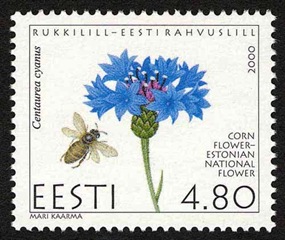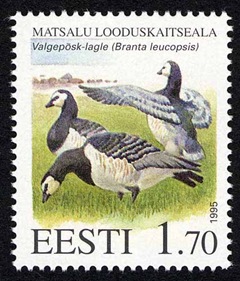The Estonia Post has collaborated with WWF organization issued the stamp series features the endangered species, Pteromys volans Lendorav or the Flying squirrel on June 27th 1994. The issuance consisted of 4 single stamps with differ face value and one First Day Cover. All issuance stamps have marked a logo of WWF.
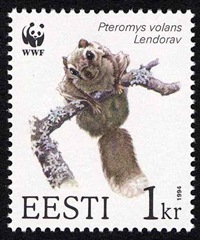
The Siberian Flying Squirrel (Pteromys volans) is an Old World flying squirrel occurs throughout Scandinavia, Russia, across northern Asia to Siberia and south along the Pacific coast of northern China including the Korean Peninsula and northeast China. Pteromys volans is the only species of flying squirrel found in Europe.It is considered vulnerable species within the European Union where it is found only in Finland and Estonia.Possibly extinct in Belarus and Lithuania.

Pteromys volans have distinct, large, black eyes. The length of the head and body is 120-228 mm with a 9–14 cm long flattened tail . A female Siberian Flying Squirrel weighs about 150 grams, the males being slightly smaller on average.The coat is grey all over, the abdomen being slightly lighter than the back, with a black stripe between the neck and the forelimb. Pteromys volans do not have a membrane between their hind limbs and the base of their tail. Their limbs are relatively short and thick and their hind feet are significantly larger than their forefeet.
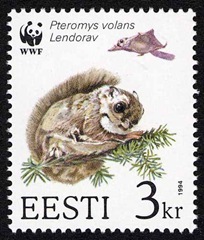
Pteromys volans are basically herbivores.The diet consists of leaves, seeds, cones, buds, sprouts, nuts, berries and occasionally bird eggs and nestlings. In the summer, they feed on green plants, young branches, berries and seeds. During the winter months, P. volans consume nuts, catkins, pine cones, and pine needles.
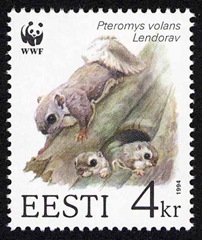
Pteromys volans are a social species; many can be found together in a single tree. They build nests in vacant tree holes or in the junction of a branch and the trunk. Nests are often inhabited by pairs.Siberian Flying Squirrels preferentially build their nest in holes made by woodpeckers, but they may also nest in birdhouses if the size of the entrance is appropriate. The nest consists of a pile of soft materials (preferably soft beard lichen) into which the squirrel burrows. Pteromys volans or a Siberian Flying Squirrel can live up to about five years.

Siberian Flying Squirrels favor old forests with a mix of conifers and deciduous trees.It prefers mature spruce-dominated forests with a significant proportion of deciduous trees, especially aspen Populus tremula, birch Betula sp. and alder Alnus sp. They are mostly nocturnal, being most active late in the evening, although females with young may also feed during the day.They are found from lowlands to montane regions. Siberian Flying Squirrels do not hibernate, but in the winter they may sometimes sleep continuously for several days.
As shy and nocturnal animals, Siberian Flying Squirrels are seldom seen. The most common sign of their presence are their droppings, which resemble orange-yellow rice grains and are often found beneath or on top of their nest.In the summer, they are active from a half hour to an hour after sunset until dawn. Most of this time is spent searching for food.During the winter, the activity is shorter and consume less food.
Modern intensive forestry and logging are the major threats to this species .Pteromys volans are hunted for commercial use of their fur..Pteromys volans are preyed upon by martens, owls, ermines, and cats.The species continues to decline in many parts of its range owing to loss of old-growth mixed forests.Possibly extinct in Belarus and Lithuania.










